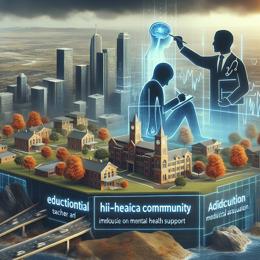Image created by AI
Long-Term Effects of Childhood Bullying on Teen Mental Health and Trust
Childhood shapes the future in myriad ways, and a shadow often cast during these formative years is that of bullying—a venomous thread in the tapestry of youth experiences. A breakthrough study co-conducted by UCLA Health and the University of Glasgow sheds light on the nexus between childhood bullying and the mental health of adolescents, unearthing the profound sequences it can trigger. The insights thus revealed point to an urgent need for educational programs, timely interventions, and robust support systems within schools, particularly in South Africa, where bullying incidents make frequent, heartrending headlines.
The extensive research published in Nature Mental Health pivots around data sourced from 10,000 UK children tracked diligently for nearly two decades. Teenagers, subjected to bullying at age 11 and hence fostering a steep sense of interpersonal distrust by age 14, are astonishingly 3.5 times more susceptible to considerable mental health issues by age 17. The issues include a spectrum from anxiety and depression to heightened levels of hyperactivity and anger. These are not mere numbers; they are poignant narratives of young lives navigating tumultuous terrain.
Dr George Slavich, a leading voice in this revelatory study, implores us to notice the alarm bells and commit to fresh, impactful interventions. His call to recognize these indicators and convert our understanding into preventative mechanisms can't be ignored. Such endeavors can indeed craft a future of resilience and wellness for the youth.
South Africa echoes these findings through its dark corridor of bullying cases—five of them etching grim milestones recently. With the World Health Organization citing suicide as the fourth leading cause of death among the youth (15 to 29-year-olds), the significance of battling bullying becomes even greater.
Bullying in its essence is a gesture of deliberate harm, decked in many insidious forms: verbal, emotional, and physical. It isn’t confined to a place or time—school premises becoming its all-too-common arena, extending from the classrooms to the cyber realms. This malaise can transform peers into silent spectators or worse, reluctant accomplices, further entrenching the victim in solitude and despair.
The repercussions are severe. According to research by the NICHD, victimized children exhibit increased risks of mental health concerns, somatic pains like headaches, and challenges in school assimilation. A dent in their self-esteem is an invisible scar that may never fade. Interestingly enough, the bullies aren't spared from the claws of these outcomes—substance abuse and violent proclivities loom in their futures. But it's the ones bearing the dual burden—as both bully and victim—whose troubles multiply and persist into adulthood, substantiating the critical importance of intervention.
South Africa's legal framework, including the South African Schools Act, mandates each school to craft a Code of Conduct to curb such transgressions. It empowers victims and witnesses to stand up against bullying, with the assurance that their voices will steer the code’s machinery into action.
These findings, overlaid with South African legalities and cultural nuances, encapsulate a stark reality—bullying's shadow looms large and lethal over school corridors worldwide. The importance of education about, and action against bullying cannot be overstressed. Only then can schools truly transform into sanctuaries of learning where trust isn't a casualty, and mental health isn't a casualty.










